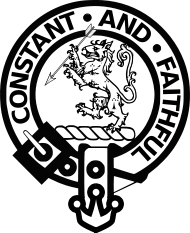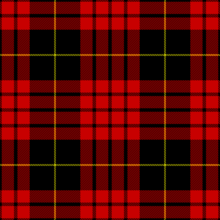- Clan Macqueen
-
Clan Macqueen / Clan Revan Crest badge 
Crest: An heraldic tyger rampant Ermine holding an arrow, point downwards Argent pheoned Gules Motto: Constant and faithful Profile Region Highland Plant badge boxwood or red whortleberry Chief Clan Macqueen / Clan Revan has no chief, and is an armigerous clan 
Arms of the last Chief of Clan Macqueen / Clan Revan Last Chief: The Macqueen of Corrybrough Allied clans Chattan Confederation
Clan Macdonald of ClanranaldClan Macqueen is a Scottish clan, formally known as MacSween, one of the ancient West Highland and Hebridean Warrior Kindreds. The clan does not have a chief recognised by the Lord Lyon King of Arms. Because of this, the clan is considered an armigerous clan, and as such Clan Macqueen has no standing under Scots Law. The clan is originally of Hebridean origin, and was incorrectly associated with the Macdonalds, who collaborated with the Anglo-Norman Robert Bruce and gained land and power at the expense of the MacSweens, who remained firm in their opposition to the Anglo-Normanisation of the Scottish Court of the Canmore Kings. In the 15th century several Macqueens settled in lands controlled by Clan Chattan. Since then, many Macqueens have lived in the north-east of Scotland. These Macqueens were followers of Clan Chattan, and were known as Clan Revan. The leading family of these Macqueens were the Macqueens of Corrybrough. Sometime in the 18th century the leading family suffered financial difficulties and lost its lands of Corrybrough.
Contents
Origin of the name
There have been numerous different origins given for the surname Macqueen. For example, it has been suggested that the surname is derived from the Gaelic personal names Suibhne and Conn. The similarly spelt surname Macquien, is considered to be often confused with, and wrongly represented by Macqueen. Most likely, however, is that the name is actually a different pronunciation of the name MacSween; the letter 'S' being aspirated after the prefix 'Mac'. Therefore, MacSween becomes MacQueen. The chiefly line of the MacSweens, based at Castle Sween in Knapdale, were forced into exile after their opposition to Robert The Bruce. In 1310 John MacSween led a celebrated but ultimately unsuccessful attempt to retake Castle Sween and their territory in Knapdale. The chiefly line conquered territory in Ireland and became fosterers and protectors of the O'Donnells, with whom they were linked by marriage. The Skipness MacSweens moved to England, where they held lands adjacent to the Balliols and Comyns in Durham. Many of the clan scattered and today the original name is found mainly on Harris and Scalpay. In Ireland, the name MacSween became McSweeney, MacSwiney, MacSwinny and other similar names.
History of the clan
During the 15th century the Macqueens were followers of the Clan Macdonald of Clanranald. During this era the tenth chief of Clan Mackintosh, Malcolm Beg Mackintosh, married Mora Macdonald of Moidart. When the Macdonald bride travelled from Macdonald lands to Mackintosh lands, she was accompanied by her kinsmen including Revan Mac Mulmor Mac Angus MacQueen. His descendants settled in the Strathearn area, acquiring the lands of Corrybrough, and became members of the Clan Chattan Confederacy. The Macqueens were subsequently known as Clan Revan.[1]
The principal family of the Macqueens of "Clan Revan" were the Lairds of Corrybrough.[2] On April 4, 1609 Donald Macqueen of Corrybrough signed a bond of manrent with several other chiefs of clans which composed of Clan Chattan, where they bound themselves to support Angus Mackintosh of that ilk as their captain and leader.[3]
Cadet branches of the Macqueens Corrybrough occupied lands in the valley of Findhorn in . The lands of Corrybrough seem to have passed from the Macqueens in the last half of the 18th century.[1] Following financial difficulties the chiefly line is thought to have emigrated from Scotland to New Zealand,[2] and although the Chiefly lineage did not die out, there has been no formal application for the Chiefship.[4][self-published source?]
Modern clan symbolism
 The Macqueen tartan, as published in the Vestiarium Scoticum in 1842. Today the Vestiarium is considered a Victorian era hoax.[5]
The Macqueen tartan, as published in the Vestiarium Scoticum in 1842. Today the Vestiarium is considered a Victorian era hoax.[5]
Today members of Scottish clans show their clan allegiance by wearing Scottish crest badges, clan tartans and sometimes clan badges (plant badges). The crest badge suitable for members of Clan Macqueen contains the heraldic crest of an heraldic tyger rampant Ermine holding an arrow, point downwards Argent pheoned Gules. The heraldic motto that appears upon the crest badge is CONSTANT AND FAITHFUL.[6] Another badge sometimes used by clan members is a clan badge (or plant badge). Several different clan badges have been attributed to various Macqueens. The Macqueens associated with Clan Chattan are attributed boxwood and red whortleberry as a clan badge. Many other Scottish clans which are closely associated with Clan Chattan have been attributed the same plants. The Macqueens of Skye, on the other hand, have common heath attributed as their clan badge. Common heath is the clan badge of many of the clans associated with Clan Donald.[7]
The Macqueen tartan was first published in 1842, in the Vestiarium Scoticum. The Vestiarium was the work of the dubious "Sobieski Stuarts" and is today considered a Victorian era hoax. The tartan is supposedly that of Clan Revan, being named after Revan MacMulmor MacAngus MacQueen who led a Macdonald bride to be married to a chief of Clan Mackintosh. The Scottish Tartans World Register (STWR) notes that the Macqueen tartan is similar to the Fraser and Gunn tartans, which both have four bold stripes. However, the STWR considers it to be a combination of the Macdonald and Mackintosh tartans.[8] The tartan scholar D. C. Stewart noted that the Macqueen tartan is the reverse of the MacKeane tartan, possibly because of the two similar sounding names, even though both names have a different history.[5]
Associated Names and Septs
The following names are historically associated with Clan MacQueen or represent variant spellings of the name:
- MacCunn
- MacSwan
- MacSwen
- MacSween
- MacSwyde
- Sween
- Swan
See also
- Clan Chattan
- McQueen, things named McQueen, MacQueen.
- McQueen (surname), the surnames McQueen, MacQueen.
Notes
- ^ a b Adam; Innes of Learney [1934] (2004), p. 103.
- ^ a b clanfinder
- ^ (????) The Scottish Clans And Their Tartans: With Notes
- ^ McQueen, R. (1999) Lineage of the Chiefs of Clan MacQueen from http://www.mngt.waikato.ac.nz/bmcqueen/webdocs/mcqueen/mcqchief.pdf
- ^ a b Stewart (1974), p. 49.
- ^ "MacQueen". MyClan (Myclan.com). Archived from the original on 2007-03-19. http://web.archive.org/web/20070319212559/www.myclan.com/clans/MacQueen_260/default.php. Retrieved 2008-09-06.
- ^ Adam; Innes of Learney (1970), pp. 541–543
- ^ "Tartan - MacQueen". Scottish Tartans World Register (scottish-tartans-world-register.com). http://www.scottish-tartans-world-register.com/tartan.aspx?record=1209. Retrieved 2008-09-22.
References
- The Scottish Clans And Their Tartans: With Notes (Library Edition ed.). Edinburgh: W. & A. K. Johnston. ????. http://www.archive.org/details/scottishclansand00edin.
- Adam, Frank; Innes of Learney, Thomas (2004) [1934]. The Clans, Septs and Regiments of the Scottish Highlands 1934. Kessinger Publishing. ISBN 1417980761.
- Adam, Frank; Innes of Learney, Thomas (1970). The Clans, Septs & Regiments of the Scottish Highlands (8th edition ed.). Edinburgh: Johnston and Bacon.
- Stewart, Donald Calder (1974). The Setts of the Scottish Tartans, with descriptive and historical notes (2nd revised ed.). London: Shepheard-Walwyn. ISBN 0 85603 011 9.
Scottish clans Clans with chiefs Agnew · Anstruther · Arbuthnott · Arthur · Bannerman · Barclay · Borthwick · Boyd · Boyle · Brodie · Broun · Bruce · Buchan · Burnett · Cameron · Campbell · Carmichael · Carnegie · Cathcart · Charteris · Chattan · Chisholm · Cochrane · Colquhoun · Colville · Cranstoun · Crichton · Cumming · Darroch · Davidson · Dewar · Drummond · Dunbar · Dundas · Durie · Elliot · Elphinstone · Erskine · Farquharson · Fergusson · Forbes · Forsyth · Fraser · Fraser of Lovat · Gayre · Gordon · Graham · Grant · Gregor · Grierson · Guthrie · Haig · Haldane · Hamilton · Hannay · Hay · Henderson · Home · Hope · Hunter · Irvine · Jardine · Johnstone · Keith · Kennedy · Kerr · Kincaid · Lamont · Leask · Lennox · Leslie · Lindsay · Lockhart · Lumsden · Lyon · MacAlister · MacBain · MacDonald · Macdonald of Clanranald · MacDonald of Keppoch · Macdonald of Sleat · MacDonell of Glengarry · MacDougall · Macdowall · MacIntyre · Mackay · Mackenzie · Mackinnon · Mackintosh · Maclachlan · Maclaine of Lochbuie · MacLaren · MacLea (Livingstone) · Maclean · MacLennan · MacLeod · MacLeod of Lewis · MacMillan · Macnab · Macnaghten · MacNeacail · MacNeil · Macpherson · MacTavish · MacThomas · Maitland · Makgill · Malcolm (MacCallum) · Mar · Marjoribanks · Matheson · Menzies · Moffat · Moncreiffe · Montgomery · Morrison · Munro · Murray · Napier · Nesbitt · Nicolson · Ogilvy · Oliphant · Primrose · Ramsay · Rattray · Riddell · Robertson · Rollo · Rose · Ross · Ruthven · Sandilands · Scott · Scrymgeour · Sempill · Shaw · Sinclair · Skene · Spens · Stirling · Strange · Stuart of Bute · Sutherland · Swinton · Trotter · Urquhart · Wallace · Wedderburn · Wemyss · Wood ·
Armigerous clans Abercromby · Abernethy · Adair · Adam · Aikenhead · Ainslie · Aiton · Allardice · Anderson · Armstrong · Arnott · Auchinleck · Baillie · Baird · Balfour · Bannatyne · Baxter · Bell · Belshes · Bethune · Beveridge · Binning · Bissett · Blackadder · Blackstock · Blair · Blane · Blyth · Boswell · Brisbane · Buchanan · Butter · Byres · Cairns · Calder · Caldwell · Callender · Campbell of Breadalbane · Campbell of Cawdor · Carruthers · Cheyne · Chalmers · Clelland · Clephane · Cockburn · Congilton · Craig · Crawford · Crosbie · Cunningham · Dalmahoy · Dalrymple · Dalzell · Dennistoun · Don · Douglas · Duncan · Dunlop · Edmonstone · Fairlie · Falconer · Fenton · Fleming · Fletcher · Forrester · Fotheringham · Fullarton · Galbraith · Galloway · Gardyne · Gartshore · Ged · Gibsone · Gladstains · Glas · Glen · Glendinning · Gray · Gunn · Haliburton · Halkerston · Halket · Hepburn · Heron · Herries · Hogg · Hopkirk · Horsburgh · Houston · Hutton · Inglis · Innes · Kelly · Kinloch · Kinnaird · Kinnear · Kinninmont · Kirkcaldy · Kirkpatrick · Laing · Lammie · Langlands · Learmonth · Little · Logan · Logie · Lundin · Lyle · MacAulay · Macbrayne · MacDuff · MacEwen · MacFarlane · Macfie · Macgillivray · MacInnes · MacIver · Mackie · MacLellan · Macquarrie · Macqueen · Macrae · Masterton · Maule · Maxton · Maxwell · McCorquodale · McCulloch · McKerrell · Meldrum · Melville · Mercer · Middleton · Moncur · Monteith · Monypenny · Mouat · Moubray · Mow · Muir · Murray of Atholl · Nairn · Nevoy · Newlands · Newton · Norvel · Ochterlony · Orrock · Paisley · Paterson · Pennycook · Pentland · Peter · Pitblado · Pitcairn · Pollock · Polwarth · Porterfield · Preston · Pringle · Purves · Rait · Ralston · Renton · Roberton · Rossie · Russell · Rutherford · Schaw · Seton · Skirving · Somerville · Spalding · Spottiswood · Stewart · Stewart of Appin · Strachan · Straiton · Strange · Sydserf · Symmers · Tailyour · Tait · Tennant · Troup · Turnbull · Tweedie · Udny · Vans · Walkinshaw · Wardlaw · Watson · Wauchope · Weir · Whitefoord · Whitelaw · Wishart · Young
Culture and society Scotland · Clan chief · Septs · Clan badge · Clan crest · Clan battles · Tartan · Bagpipes · Clearances · Kilt · Manrent · The Highlands · Battle of Culloden · Highland games · Border Reivers · Scottish heraldry · Scottish surnames
Categories:- Scottish clans
- Armigerous clans
Wikimedia Foundation. 2010.
